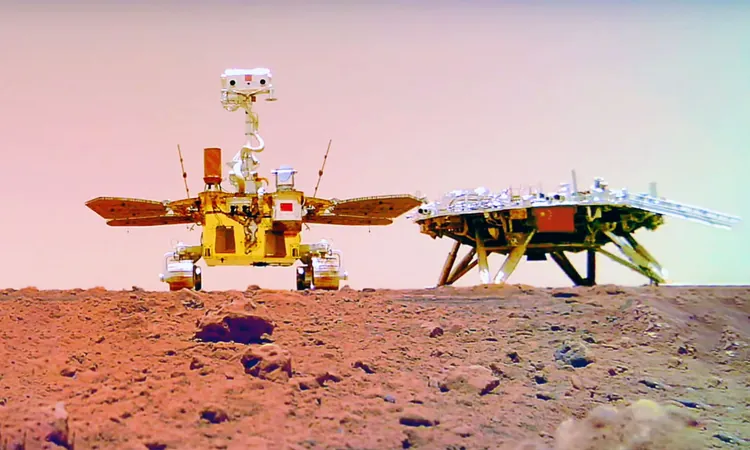
Revolutionary Discovery: Mars Zhurong Rover Uncovers Evidence of Ancient Ocean Shoreline!
2024-11-26
Author: Yan
The intrigue surrounding Mars has taken an exciting turn with recent findings from China’s Zhurong rover, reigniting conversations about the planet’s potential to have hosted large bodies of water in its distant past.
After its historic landing in the southern Utopia Planitia region of Mars in May 2021, the now-inactive Zhurong rover has provided scientists with groundbreaking insights that could reshape our understanding of Martian history. Researchers, led by Bo Wu at Hong Kong Polytechnic University, have announced compelling evidence of what appears to be an ancient shoreline from a vast ocean that once blanketed Mars’ northern lowlands.
Unpacking the Zhurong Rover's Capabilities
Zhurong, weighing approximately 240 kilograms—comparable to a small car—is equipped with a suite of advanced scientific instruments. These include high-resolution navigation and topography cameras, a multispectral camera designed for surface material analysis, and cutting-edge ground-penetrating radar capable of reaching depths of up to 100 meters. This sophisticated toolkit enables Zhurong to collect detailed data on Martian geology and identify potential signs of water ice beneath the surface.
The rover’s ability to analyze both surface and subsurface features is crucial, particularly in the search for evidence of water, essential for understanding the planet's past environmental conditions.
Identifying Water Features on Mars
Zhurong's exploration has yielded fascinating results. Using a combination of its onboard instruments and information from satellites orbiting Mars, the research team identified several noteworthy geological formations near its landing site. These include crater-like structures, troughs, sediment channels, and mud volcanoes—features reminiscent of a coastal environment. The consistency of these formations with nearshore geological characteristics suggests that this region may have once formed the boundary of a Martian coastline.
Based on geological analysis, the researchers estimate that the ocean could have existed as recently as 3.68 billion years ago, with evidence indicating that the water was heavily silted, creating layered deposits similar to those found on ancient seabeds on Earth. Intriguingly, it’s hypothesized that after its creation, the ocean may have frozen over for a period of 10,000 to 100,000 years before eventually desiccating approximately 260 million years later.
Skepticism and Scientific Discourse
Despite the tantalizing findings, not all experts agree on the interpretation of Zhurong's data. Benjamin Cardenas from Pennsylvania State University cautions that the erosive forces at play on Mars over billions of years would likely obscure such features. Wu acknowledges this skepticism, proposing that asteroid impacts could have resurfaced parts of the coastline, keeping some remnants detectable today.
What This Means for the Search for Life
The implications of this research are monumental. Water is a critical ingredient for life as we know it. If Mars indeed hosted oceans, the possibilities of past life forms existing on the planet are tantalizing. This question echoes through the scientific community, driving ongoing research and exploration.
Adding further weight to this hypothesis, NASA’s InSight lander has previously detected significant amounts of water seeping into the Martian crust, suggesting potential environments that could sustain life.
Looking to the Future: Sample Returns from Mars
As we contemplate these findings, the road ahead is filled with promise. China's Tianwen-3 mission, scheduled for 2031, aims to return Martian soil samples to Earth, potentially providing even more insights than what robotic missions can reveal. This endeavor stands to outpace NASA’s own comparable initiatives, bringing Martian material back to our laboratories for detailed analysis.
In the meantime, Zhurong continues to transmit valuable data, bringing us closer to unlocking the mysteries of Mars’ watery past. Could the Red Planet have supported life billions of years ago? It’s a question that captivates scientists and enthusiasts alike, underscoring the endless quest for knowledge about our solar system.
This revolutionary study was featured in the journal Scientific Reports, marking an exciting chapter in planetary exploration that many will be eager to follow. Stay tuned for more updates as we draw nearer to unraveling the enigmatic history of Mars!


 Brasil (PT)
Brasil (PT)
 Canada (EN)
Canada (EN)
 Chile (ES)
Chile (ES)
 España (ES)
España (ES)
 France (FR)
France (FR)
 Hong Kong (EN)
Hong Kong (EN)
 Italia (IT)
Italia (IT)
 日本 (JA)
日本 (JA)
 Magyarország (HU)
Magyarország (HU)
 Norge (NO)
Norge (NO)
 Polska (PL)
Polska (PL)
 Schweiz (DE)
Schweiz (DE)
 Singapore (EN)
Singapore (EN)
 Sverige (SV)
Sverige (SV)
 Suomi (FI)
Suomi (FI)
 Türkiye (TR)
Türkiye (TR)